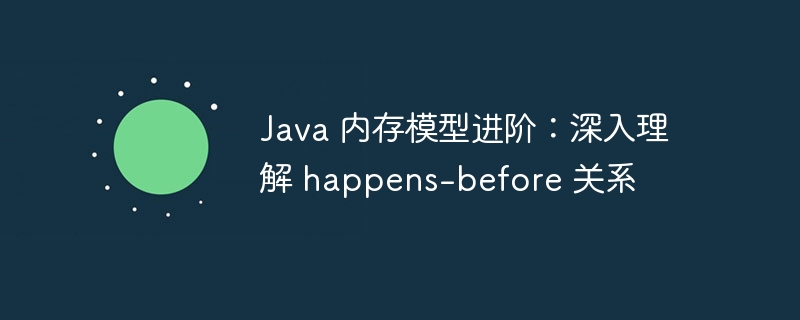Home >Java >javaTutorial >Advanced Java memory model: in-depth understanding of happens-before relationship
Advanced Java memory model: in-depth understanding of happens-before relationship
- WBOYWBOYWBOYWBOYWBOYWBOYWBOYWBOYWBOYWBOYWBOYWBOYWBforward
- 2024-02-19 16:42:08723browse

php editor Apple introduces you to the advanced Java memory model: in-depth understanding of the happens-before relationship. The Java memory model defines how threads interact with each other, and the happens-before relationship is one of the important concepts. A deep understanding of the happens-before relationship helps us better master multi-threaded programming and avoid data competition and memory visibility problems. By learning the happens-before relationship, we can better understand the interaction rules between threads in Java programs and improve the concurrency performance of the program.
happens-before relationship is a partial ordering relationship defined by JMM. It stipulates the order of memory operations between threads and ensures thread safety and concurrent programming correctness. happens-before relationships are mainly divided into the following categories:
- Program sequence rules: The operations in a thread are executed in the order of the program code, that is, the previous operation must be executed before the next operation.
- Pipeline rules: If one thread A writes a value to a shared variable, and then another thread B reads the value from the same shared variable, then the write operation in A must precede the read operation in B occur.
- LockRule: If a thread A acquires a lock, and then another thread B attempts to acquire the same lock, then the lock operation in A must occur before the lock operation in B.
- volatile variable rules: If a thread A writes the value of a volatile variable to main memory, and then another thread B reads the value from the same volatile variable, then the write operation in A must be in B Occurs before the read operation.
- Thread startup rules: When a thread A starts another thread B, the thread startup operation in A must occur before the thread in B performs the operation.
- Thread termination rules: When a thread A terminates, the thread termination operation in A must occur before the references to A in other threads become invalid.
2. Application of happens-before relationship
happens-before relationships are widely used in Java ConcurrencyProgramming, including:
- Thread safety: By ensuring that access to shared variables follows the happens-before relationship, data races and memory visibility issues can be avoided, thereby achieving thread safety.
- Synchronization: The happens-before relationship can be used to implement synchronization mechanisms, such as locks and fences, to ensure that threads execute in the correct order.
- Memory barrier: The happens-before relationship can be used to implement a memory barrier to prevent instruction reordering from affecting the correctness of the program. volatile variables: The happens-before relationship can be used to understand and use volatile variables to ensure that access to volatile variables follows the correct order.
- Concurrency
- Data structure: happens-before relationships can be used to design and implement concurrent data structures, such as atomic operations and lock-free data structures, to ensure the correctness and consistency of data.
3. Frequently Asked Questions about happens-before relationships
When using the happens-before relationship, we often encounter some common problems, including:
- How to determine whether there is a happens-before relationship between two operations?
- How to ensure that access to shared variables follows the happens-before relationship?
- How to deal with the impact of instruction reordering on happens-before relationships?
- How to use volatile variables correctly in Java concurrent programming?
- How to design and implement thread-safe concurrent data structures?
4. Conclusion
The happens-before relationship is one of the core concepts of the Java memory model. It specifies the order of memory operations between threads and is crucial for thread safety and concurrent programming. This article delves into the basics, applications, and common problems of the happens-before relationship to help readers fully understand this important concept and apply it to actual Java concurrent programming.The above is the detailed content of Advanced Java memory model: in-depth understanding of happens-before relationship. For more information, please follow other related articles on the PHP Chinese website!

